云计算-专业英语论文
A View of Cloud Computing
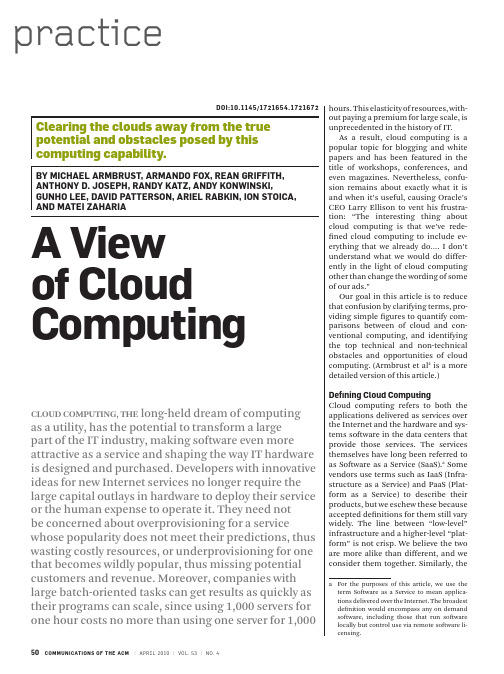
communicatio ns o f th e acm | apr i l 201 0 | vol. 5 3 | no. 4
hours. This elasticity of resources, without paying a premium for large scale, is unprecedented in the history of IT. As a result, cloud computing is a popular topic for blogging and white papers and has been featured in the title of workshops, conferences, and even magazines. Nevertheless, confusion remains about exactly what it is and when it’s useful, causing Oracle’s CEO Larry Ellison to vent his frustration: “The interesting thing about cloud computing is that we’ve redefined cloud computing to include everything that we already do…. I don’t understand what we would do differently in the light of cloud computing other than change the wording of some of our ads.” Our goal in this article is to reduce that confusion by clarifying terms, providing simple figures to quantify comparisons between of cloud and conventional computing, and identifying the top technical and non-technical obstacles and opportunities of cloud computing. (Armbrust et al4 is a more detailed version of this article.) Defining Cloud Computing Cloud computing refers to both the applications delivered as services over the Internet and the hardware and systems software in the data centers that provide those services. The services themselves have long been referred to as Software as a Service (SaaS).a Some vendors use terms such as IaaS (Infrastructure as a Service) and PaaS (Platform as a Service) to describe their products, but we eschew these because accepted definitions for them still vary widely. The line between “low-level” infrastructure and a higher-level “platform” is not crisp. We believe the two are more alike than different, and we consider them together. Similarly, the
关于云计算的英语作文

关于云计算的英语作文英文回答:Cloud computing has revolutionized the way businesses and individuals store, process, and access data and applications. As a result, there are multiple benefits of cloud computing, including improved flexibility, reduced costs, increased security, enhanced collaboration, and innovative services.Flexibility is one of the key advantages of cloud computing. It allows users to access their data and applications from anywhere with an internet connection. This makes it easier for businesses to operate remotely and for individuals to work from home.Reduced costs are another advantage of cloud computing. Businesses can avoid the upfront costs of purchasing and maintaining their own IT infrastructure. Instead, they can pay for cloud services on a pay-as-you-go basis.Increased security is another key benefit of cloud computing. Cloud providers have invested heavily insecurity measures to protect their customers' data. This makes cloud computing a more secure option than storingdata on-premises.Enhanced collaboration is another advantage of cloud computing. Cloud-based applications make it easier forteams to collaborate on projects. This is because cloud applications can be accessed from anywhere, and they allow users to share files and collaborate in real-time.Innovative services are another key benefit of cloud computing. Cloud providers are constantly developing new services, such as artificial intelligence, machine learning, and data analytics. These services can help businesses improve their operations and make better decisions.Overall, cloud computing offers a number of benefitsthat can help businesses and individuals improve their operations, reduce costs, and increase innovation.中文回答:云计算的优势。
云计算技术在大学英语教学中的应用研究
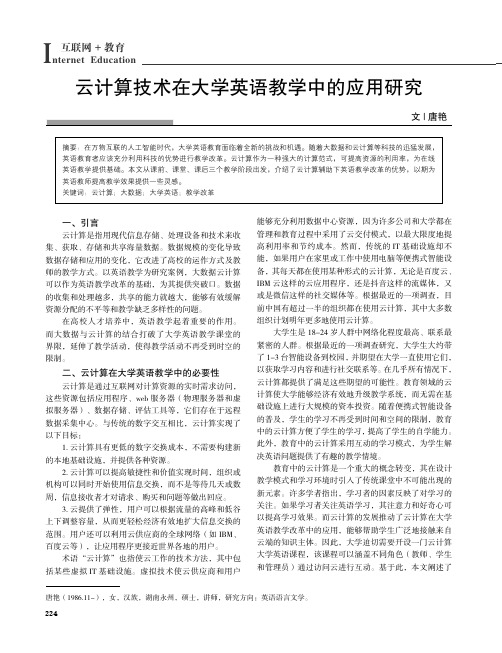
I nternet Education互联网+教育一、引言云计算是指用现代信息存储、处理设备和技术来收集、获取、存储和共享海量数据。
数据规模的变化导致数据存储和应用的变化,它改进了高校的运作方式及教师的教学方式。
以英语教学为研究案例,大数据云计算可以作为英语教学改革的基础,为其提供突破口。
数据的收集和处理越多,共享的能力就越大,能够有效缓解资源分配的不平等和教学缺乏多样性的问题。
在高校人才培养中,英语教学起着重要的作用。
而大数据与云计算的结合打破了大学英语教学课堂的界限,延伸了教学活动,使得教学活动不再受到时空的限制。
二、云计算在大学英语教学中的必要性云计算是通过互联网对计算资源的实时需求访问,这些资源包括应用程序、web服务器(物理服务器和虚拟服务器)、数据存储、评估工具等,它们存在于远程数据采集中心。
与传统的数字交互相比,云计算实现了以下目标:1.云计算具有更低的数字交换成本,不需要构建新的本地基础设施,并提供各种资源。
2.云计算可以提高敏捷性和价值实现时间,组织或机构可以同时开始使用信息交换,而不是等待几天或数周,信息接收者才对请求、购买和问题等做出回应。
3.云提供了弹性,用户可以根据流量的高峰和低谷上下调整容量,从而更轻松经济有效地扩大信息交换的范围。
用户还可以利用云供应商的全球网络(如IBM、百度云等),让应用程序更接近世界各地的用户。
术语“云计算”也指使云工作的技术方法,其中包括某些虚拟IT基础设施。
虚拟技术使云供应商和用户能够充分利用数据中心资源,因为许多公司和大学都在管理和教育过程中采用了云交付模式,以最大限度地提高利用率和节约成本。
然而,传统的IT基础设施却不能,如果用户在家里或工作中使用电脑等便携式智能设备,其每天都在使用某种形式的云计算,无论是百度云、IBM云这样的云应用程序,还是抖音这样的流媒体,又或是微信这样的社交媒体等。
根据最近的一项调查,目前中国有超过一半的组织都在使用云计算,其中大多数组织计划明年更多地使用云计算。
Google_云计算三大论文中文版
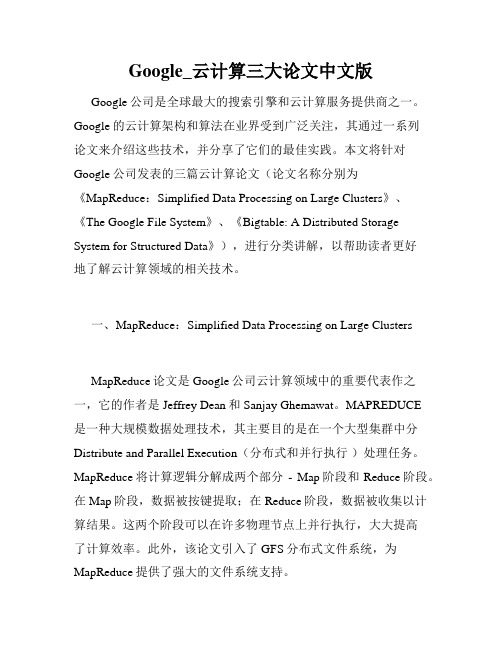
Google_云计算三大论文中文版Google公司是全球最大的搜索引擎和云计算服务提供商之一。
Google的云计算架构和算法在业界受到广泛关注,其通过一系列论文来介绍这些技术,并分享了它们的最佳实践。
本文将针对Google公司发表的三篇云计算论文(论文名称分别为《MapReduce:Simplified Data Processing on Large Clusters》、《The Google File System》、《Bigtable: A Distributed Storage System for Structured Data》),进行分类讲解,以帮助读者更好地了解云计算领域的相关技术。
一、MapReduce:Simplified Data Processing on Large ClustersMapReduce论文是Google公司云计算领域中的重要代表作之一,它的作者是Jeffrey Dean和Sanjay Ghemawat。
MAPREDUCE是一种大规模数据处理技术,其主要目的是在一个大型集群中分Distribute and Parallel Execution(分布式和并行执行)处理任务。
MapReduce将计算逻辑分解成两个部分- Map阶段和Reduce阶段。
在Map阶段,数据被按键提取;在Reduce阶段,数据被收集以计算结果。
这两个阶段可以在许多物理节点上并行执行,大大提高了计算效率。
此外,该论文引入了GFS分布式文件系统,为MapReduce提供了强大的文件系统支持。
二、The Google File SystemGFS是由Sanjay Ghemawat、Howard Gobioff和Shun-TakLeung共同编写的一篇论文。
它旨在解决分布式文件系统上的问题,以应对Google的大规模数据集和两台甚至三台以上的机器发生故障的情况。
GFS可以处理超过100TB以上的数据集,加速数据读取和写入,处理大规模数据存储集群。
大学英语计算机专业作文
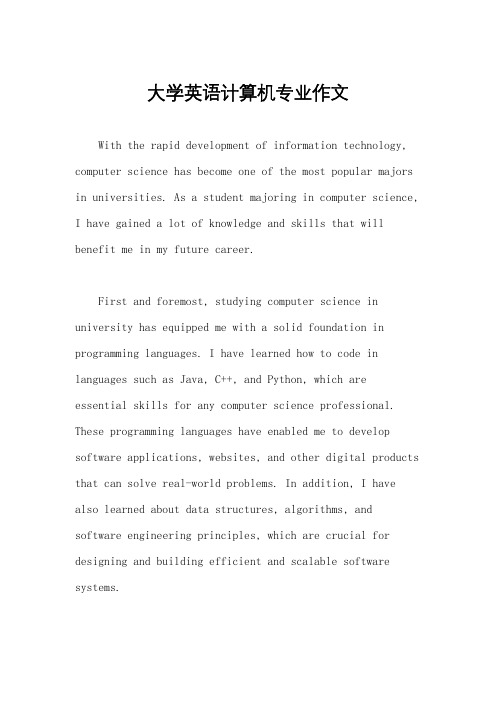
大学英语计算机专业作文With the rapid development of information technology, computer science has become one of the most popular majors in universities. As a student majoring in computer science, I have gained a lot of knowledge and skills that will benefit me in my future career.First and foremost, studying computer science in university has equipped me with a solid foundation in programming languages. I have learned how to code in languages such as Java, C++, and Python, which areessential skills for any computer science professional. These programming languages have enabled me to develop software applications, websites, and other digital products that can solve real-world problems. In addition, I have also learned about data structures, algorithms, and software engineering principles, which are crucial for designing and building efficient and scalable software systems.Moreover, studying computer science has provided mewith opportunities to work on various projects and assignments that have challenged me to think critically and creatively. I have collaborated with my classmates on group projects, where we have designed and implemented software solutions for different problems. These projects have allowed me to apply the theoretical knowledge I havelearned in class to practical situations, and have helpedme develop my problem-solving skills and teamwork abilities.Furthermore, studying computer science has opened up a wide range of career opportunities for me. With a degree in computer science, I can pursue a career as a software developer, data analyst, cybersecurity specialist, or any other role in the tech industry. The demand for computer science professionals is high, and companies are constantly looking for talented individuals who can help them innovate and stay competitive in the digital age. By studying computer science, I have positioned myself for a successful and rewarding career in the technology sector.In conclusion, studying computer science in universityhas been a valuable and enriching experience for me. I have gained a strong foundation in programming languages, developed my problem-solving and teamwork skills, and opened up a world of career opportunities in the tech industry. I am confident that the knowledge and skills I have acquired through my computer science education will serve me well in my future career, and I am excited to see where this journey will take me.。
我对云计算的看法英语作文
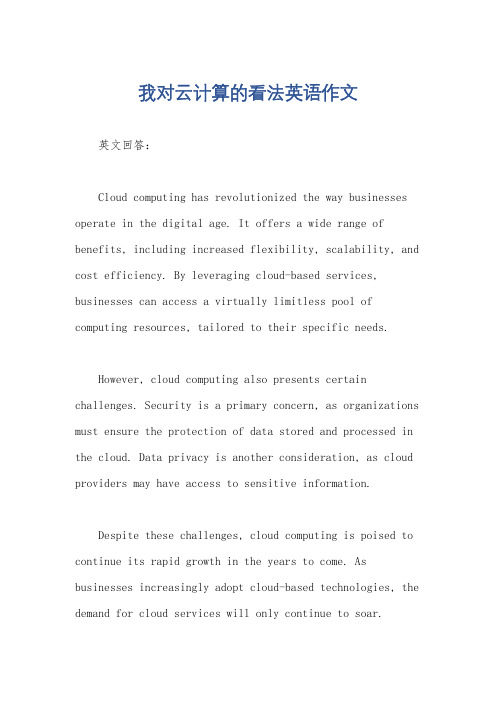
我对云计算的看法英语作文英文回答:Cloud computing has revolutionized the way businesses operate in the digital age. It offers a wide range of benefits, including increased flexibility, scalability, and cost efficiency. By leveraging cloud-based services, businesses can access a virtually limitless pool of computing resources, tailored to their specific needs.However, cloud computing also presents certain challenges. Security is a primary concern, as organizations must ensure the protection of data stored and processed in the cloud. Data privacy is another consideration, as cloud providers may have access to sensitive information.Despite these challenges, cloud computing is poised to continue its rapid growth in the years to come. As businesses increasingly adopt cloud-based technologies, the demand for cloud services will only continue to soar.中文回答:云计算彻底改变了企业在数字时代中的运营方式。
云计算Cloud-Computing-外文翻译
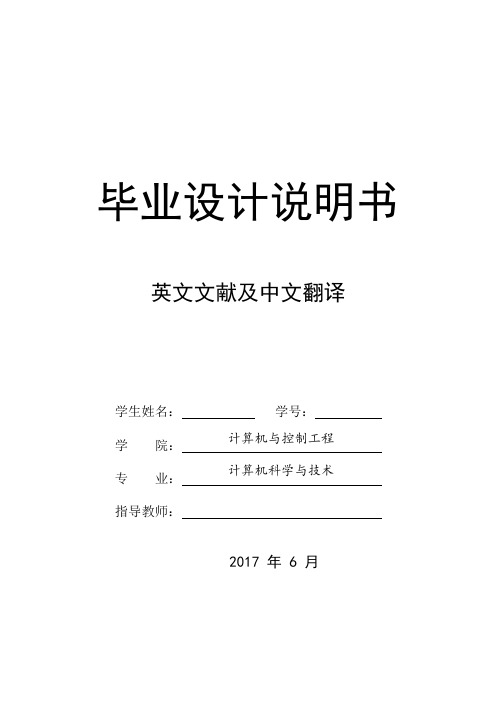
毕业设计说明书英文文献及中文翻译学生姓名:学号:计算机与控制工程学院:专指导教师:2017 年 6 月英文文献Cloud Computing1。
Cloud Computing at a Higher LevelIn many ways,cloud computing is simply a metaphor for the Internet, the increasing movement of compute and data resources onto the Web. But there's a difference: cloud computing represents a new tipping point for the value of network computing. It delivers higher efficiency, massive scalability, and faster,easier software development. It's about new programming models,new IT infrastructure, and the enabling of new business models。
For those developers and enterprises who want to embrace cloud computing, Sun is developing critical technologies to deliver enterprise scale and systemic qualities to this new paradigm:(1) Interoperability —while most current clouds offer closed platforms and vendor lock—in, developers clamor for interoperability。
云计算外文翻译参考文献
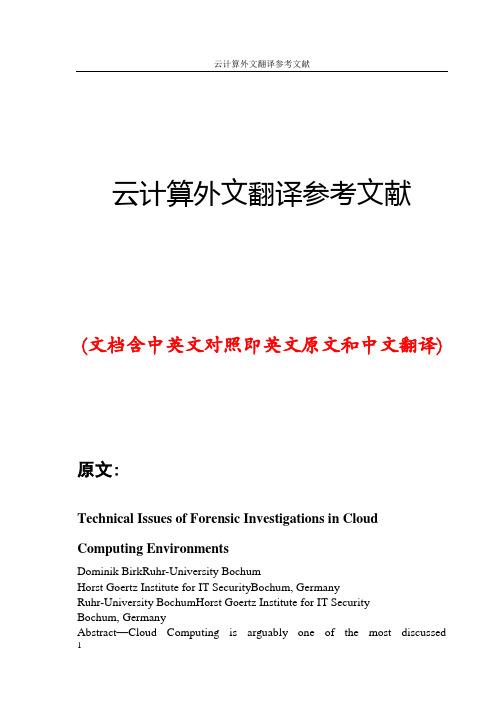
云计算外文翻译参考文献(文档含中英文对照即英文原文和中文翻译)原文:Technical Issues of Forensic Investigations in Cloud Computing EnvironmentsDominik BirkRuhr-University BochumHorst Goertz Institute for IT SecurityBochum, GermanyRuhr-University BochumHorst Goertz Institute for IT SecurityBochum, GermanyAbstract—Cloud Computing is arguably one of the most discussedinformation technologies today. It presents many promising technological and economical opportunities. However, many customers remain reluctant to move their business IT infrastructure completely to the cloud. One of their main concerns is Cloud Security and the threat of the unknown. Cloud Service Providers(CSP) encourage this perception by not letting their customers see what is behind their virtual curtain. A seldomly discussed, but in this regard highly relevant open issue is the ability to perform digital investigations. This continues to fuel insecurity on the sides of both providers and customers. Cloud Forensics constitutes a new and disruptive challenge for investigators. Due to the decentralized nature of data processing in the cloud, traditional approaches to evidence collection and recovery are no longer practical. This paper focuses on the technical aspects of digital forensics in distributed cloud environments. We contribute by assessing whether it is possible for the customer of cloud computing services to perform a traditional digital investigation from a technical point of view. Furthermore we discuss possible solutions and possible new methodologies helping customers to perform such investigations.I. INTRODUCTIONAlthough the cloud might appear attractive to small as well as to large companies, it does not come along without its own unique problems. Outsourcing sensitive corporate data into the cloud raises concerns regarding the privacy and security of data. Security policies, companies main pillar concerning security, cannot be easily deployed into distributed, virtualized cloud environments. This situation is further complicated by the unknown physical location of the companie’s assets. Normally,if a security incident occurs, the corporate security team wants to be able to perform their own investigation without dependency on third parties. In the cloud, this is not possible anymore: The CSP obtains all the power over the environmentand thus controls the sources of evidence. In the best case, a trusted third party acts as a trustee and guarantees for the trustworthiness of the CSP. Furthermore, the implementation of the technical architecture and circumstances within cloud computing environments bias the way an investigation may be processed. In detail, evidence data has to be interpreted by an investigator in a We would like to thank the reviewers for the helpful comments and Dennis Heinson (Center for Advanced Security Research Darmstadt - CASED) for the profound discussions regarding the legal aspects of cloud forensics. proper manner which is hardly be possible due to the lackof circumstantial information. For auditors, this situation does not change: Questions who accessed specific data and information cannot be answered by the customers, if no corresponding logs are available. With the increasing demand for using the power of the cloud for processing also sensible information and data, enterprises face the issue of Data and Process Provenance in the cloud [10]. Digital provenance, meaning meta-data that describes the ancestry or history of a digital object, is a crucial feature for forensic investigations. In combination with a suitable authentication scheme, it provides information about who created and who modified what kind of data in the cloud. These are crucial aspects for digital investigations in distributed environments such as the cloud. Unfortunately, the aspects of forensic investigations in distributed environment have so far been mostly neglected by the research community. Current discussion centers mostly around security, privacy and data protection issues [35], [9], [12]. The impact of forensic investigations on cloud environments was little noticed albeit mentioned by the authors of [1] in 2009: ”[...] to our knowledge, no research has been published on how cloud computing environments affect digital artifacts,and on acquisition logistics and legal issues related to cloud computing env ironments.” This statement is also confirmed by other authors [34], [36], [40] stressing that further research on incident handling, evidence tracking and accountability in cloud environments has to be done. At the same time, massive investments are being made in cloud technology. Combined with the fact that information technology increasingly transcendents peoples’ private and professional life, thus mirroring more and more of peoples’actions, it becomes apparent that evidence gathered from cloud environments will be of high significance to litigation or criminal proceedings in the future. Within this work, we focus the notion of cloud forensics by addressing the technical issues of forensics in all three major cloud service models and consider cross-disciplinary aspects. Moreover, we address the usability of various sources of evidence for investigative purposes and propose potential solutions to the issues from a practical standpoint. This work should be considered as a surveying discussion of an almost unexplored research area. The paper is organized as follows: We discuss the related work and the fundamental technical background information of digital forensics, cloud computing and the fault model in section II and III. In section IV, we focus on the technical issues of cloud forensics and discuss the potential sources and nature of digital evidence as well as investigations in XaaS environments including thecross-disciplinary aspects. We conclude in section V.II. RELATED WORKVarious works have been published in the field of cloud security and privacy [9], [35], [30] focussing on aspects for protecting data in multi-tenant, virtualized environments. Desired security characteristics for current cloud infrastructures mainly revolve around isolation of multi-tenant platforms [12], security of hypervisors in order to protect virtualized guest systems and secure network infrastructures [32]. Albeit digital provenance, describing the ancestry of digital objects, still remains a challenging issue for cloud environments, several works have already been published in this field [8], [10] contributing to the issues of cloud forensis. Within this context, cryptographic proofs for verifying data integrity mainly in cloud storage offers have been proposed,yet lacking of practical implementations [24], [37], [23]. Traditional computer forensics has already well researched methods for various fields of application [4], [5], [6], [11], [13]. Also the aspects of forensics in virtual systems have been addressed by several works [2], [3], [20] including the notionof virtual introspection [25]. In addition, the NIST already addressed Web Service Forensics [22] which has a huge impact on investigation processes in cloud computing environments. In contrast, the aspects of forensic investigations in cloud environments have mostly been neglected by both the industry and the research community. One of the first papers focusing on this topic was published by Wolthusen [40] after Bebee et al already introduced problems within cloud environments [1]. Wolthusen stressed that there is an inherent strong need for interdisciplinary work linking the requirements and concepts of evidence arising from the legal field to what can be feasibly reconstructed and inferred algorithmically or in an exploratory manner. In 2010, Grobauer et al [36] published a paper discussing the issues of incident response in cloud environments - unfortunately no specific issues and solutions of cloud forensics have been proposed which will be done within this work.III. TECHNICAL BACKGROUNDA. Traditional Digital ForensicsThe notion of Digital Forensics is widely known as the practice of identifying, extracting and considering evidence from digital media. Unfortunately, digital evidence is both fragile and volatile and therefore requires the attention of special personnel and methods in order to ensure that evidence data can be proper isolated and evaluated. Normally, the process of a digital investigation can be separated into three different steps each having its own specificpurpose:1) In the Securing Phase, the major intention is the preservation of evidence for analysis. The data has to be collected in a manner that maximizes its integrity. This is normally done by a bitwise copy of the original media. As can be imagined, this represents a huge problem in the field of cloud computing where you never know exactly where your data is and additionallydo not have access to any physical hardware. However, the snapshot technology, discussed in section IV-B3, provides a powerful tool to freeze system states and thus makes digital investigations, at least in IaaS scenarios, theoretically possible.2) We refer to the Analyzing Phase as the stage in which the data is sifted and combined. It is in this phase that the data from multiple systems or sources is pulled together to create as complete a picture and event reconstruction as possible. Especially in distributed system infrastructures, this means that bits and pieces of data are pulled together for deciphering the real story of what happened and for providing a deeper look into the data.3) Finally, at the end of the examination and analysis of the data, the results of the previous phases will be reprocessed in the Presentation Phase. The report, created in this phase, is a compilation of all the documentation and evidence from the analysis stage. The main intention of such a report is that it contains all results, it is complete and clear to understand. Apparently, the success of these three steps strongly depends on the first stage. If it is not possible to secure the complete set of evidence data, no exhaustive analysis will be possible. However, in real world scenarios often only a subset of the evidence data can be secured by the investigator. In addition, an important definition in the general context of forensics is the notion of a Chain of Custody. This chain clarifies how and where evidence is stored and who takes possession of it. Especially for cases which are brought to court it is crucial that the chain of custody is preserved.B. Cloud ComputingAccording to the NIST [16], cloud computing is a model for enabling convenient, on-demand network access to a shared pool of configurable computing resources (e.g., networks, servers, storage, applications and services) that can be rapidly provisioned and released with minimal CSP interaction. The new raw definition of cloud computing brought several new characteristics such as multi-tenancy, elasticity, pay-as-you-go and reliability. Within this work, the following three models are used: In the Infrastructure asa Service (IaaS) model, the customer is using the virtual machine provided by the CSP for installing his own system on it. The system can be used like any other physical computer with a few limitations. However, the additive customer power over the system comes along with additional security obligations. Platform as a Service (PaaS) offerings provide the capability to deploy application packages created using the virtual development environment supported by the CSP. For the efficiency of software development process this service model can be propellent. In the Software as a Service (SaaS) model, the customer makes use of a service run by the CSP on a cloud infrastructure. In most of the cases this service can be accessed through an API for a thin client interface such as a web browser. Closed-source public SaaS offers such as Amazon S3 and GoogleMail can only be used in the public deployment model leading to further issues concerning security, privacy and the gathering of suitable evidences. Furthermore, two main deployment models, private and public cloud have to be distinguished. Common public clouds are made available to the general public. The corresponding infrastructure is owned by one organization acting as a CSP and offering services to its customers. In contrast, the private cloud is exclusively operated for an organization but may not provide the scalability and agility of public offers. The additional notions of community and hybrid cloud are not exclusively covered within this work. However, independently from the specific model used, the movement of applications and data to the cloud comes along with limited control for the customer about the application itself, the data pushed into the applications and also about the underlying technical infrastructure.C. Fault ModelBe it an account for a SaaS application, a development environment (PaaS) or a virtual image of an IaaS environment, systems in the cloud can be affected by inconsistencies. Hence, for both customer and CSP it is crucial to have the ability to assign faults to the causing party, even in the presence of Byzantine behavior [33]. Generally, inconsistencies can be caused by the following two reasons:1) Maliciously Intended FaultsInternal or external adversaries with specific malicious intentions can cause faults on cloud instances or applications. Economic rivals as well as former employees can be the reason for these faults and state a constant threat to customers and CSP. In this model, also a malicious CSP is included albeit he isassumed to be rare in real world scenarios. Additionally, from the technical point of view, the movement of computing power to a virtualized, multi-tenant environment can pose further threads and risks to the systems. One reason for this is that if a single system or service in the cloud is compromised, all other guest systems and even the host system are at risk. Hence, besides the need for further security measures, precautions for potential forensic investigations have to be taken into consideration.2) Unintentional FaultsInconsistencies in technical systems or processes in the cloud do not have implicitly to be caused by malicious intent. Internal communication errors or human failures can lead to issues in the services offered to the costumer(i.e. loss or modification of data). Although these failures are not caused intentionally, both the CSP and the customer have a strong intention to discover the reasons and deploy corresponding fixes.IV. TECHNICAL ISSUESDigital investigations are about control of forensic evidence data. From the technical standpoint, this data can be available in three different states: at rest, in motion or in execution. Data at rest is represented by allocated disk space. Whether the data is stored in a database or in a specific file format, it allocates disk space. Furthermore, if a file is deleted, the disk space is de-allocated for the operating system but the data is still accessible since the disk space has not been re-allocated and overwritten. This fact is often exploited by investigators which explore these de-allocated disk space on harddisks. In case the data is in motion, data is transferred from one entity to another e.g. a typical file transfer over a network can be seen as a data in motion scenario. Several encapsulated protocols contain the data each leaving specific traces on systems and network devices which can in return be used by investigators. Data can be loaded into memory and executed as a process. In this case, the data is neither at rest or in motion but in execution. On the executing system, process information, machine instruction and allocated/de-allocated data can be analyzed by creating a snapshot of the current system state. In the following sections, we point out the potential sources for evidential data in cloud environments and discuss the technical issues of digital investigations in XaaS environmentsas well as suggest several solutions to these problems.A. Sources and Nature of EvidenceConcerning the technical aspects of forensic investigations, the amount of potential evidence available to the investigator strongly diverges between thedifferent cloud service and deployment models. The virtual machine (VM), hosting in most of the cases the server application, provides several pieces of information that could be used by investigators. On the network level, network components can provide information about possible communication channels between different parties involved. The browser on the client, acting often as the user agent for communicating with the cloud, also contains a lot of information that could be used as evidence in a forensic investigation. Independently from the used model, the following three components could act as sources for potential evidential data.1) Virtual Cloud Instance: The VM within the cloud, where i.e. data is stored or processes are handled, contains potential evidence [2], [3]. In most of the cases, it is the place where an incident happened and hence provides a good starting point for a forensic investigation. The VM instance can be accessed by both, the CSP and the customer who is running the instance. Furthermore, virtual introspection techniques [25] provide access to the runtime state of the VM via the hypervisor and snapshot technology supplies a powerful technique for the customer to freeze specific states of the VM. Therefore, virtual instances can be still running during analysis which leads to the case of live investigations [41] or can be turned off leading to static image analysis. In SaaS and PaaS scenarios, the ability to access the virtual instance for gathering evidential information is highly limited or simply not possible.2) Network Layer: Traditional network forensics is knownas the analysis of network traffic logs for tracing events that have occurred in the past. Since the different ISO/OSI network layers provide several information on protocols and communication between instances within as well as with instances outside the cloud [4], [5], [6], network forensics is theoretically also feasible in cloud environments. However in practice, ordinary CSP currently do not provide any log data from the network components used by the customer’s instances or applications. For instance, in case of a malware infection of an IaaS VM, it will be difficult for the investigator to get any form of routing information and network log datain general which is crucial for further investigative steps. This situation gets even more complicated in case of PaaS or SaaS. So again, the situation of gathering forensic evidence is strongly affected by the support the investigator receives from the customer and the CSP.3) Client System: On the system layer of the client, it completely depends on the used model (IaaS, PaaS, SaaS) if and where potential evidence could beextracted. In most of the scenarios, the user agent (e.g. the web browser) on the client system is the only application that communicates with the service in the cloud. This especially holds for SaaS applications which are used and controlled by the web browser. But also in IaaS scenarios, the administration interface is often controlled via the browser. Hence, in an exhaustive forensic investigation, the evidence data gathered from the browser environment [7] should not be omitted.a) Browser Forensics: Generally, the circumstances leading to an investigation have to be differentiated: In ordinary scenarios, the main goal of an investigation of the web browser is to determine if a user has been victim of a crime. In complex SaaS scenarios with high client-server interaction, this constitutes a difficult task. Additionally, customers strongly make use of third-party extensions [17] which can be abused for malicious purposes. Hence, the investigator might want to look for malicious extensions, searches performed, websites visited, files downloaded, information entered in forms or stored in local HTML5 stores, web-based email contents and persistent browser cookies for gathering potential evidence data. Within this context, it is inevitable to investigate the appearance of malicious JavaScript [18] leading to e.g. unintended AJAX requests and hence modified usage of administration interfaces. Generally, the web browser contains a lot of electronic evidence data that could be used to give an answer to both of the above questions - even if the private mode is switched on [19].B. Investigations in XaaS EnvironmentsTraditional digital forensic methodologies permit investigators to seize equipment and perform detailed analysis on the media and data recovered [11]. In a distributed infrastructure organization like the cloud computing environment, investigators are confronted with an entirely different situation. They have no longer the option of seizing physical data storage. Data and processes of the customer are dispensed over an undisclosed amount of virtual instances, applications and network elements. Hence, it is in question whether preliminary findings of the computer forensic community in the field of digital forensics apparently have to be revised and adapted to the new environment. Within this section, specific issues of investigations in SaaS, PaaS and IaaS environments will be discussed. In addition, cross-disciplinary issues which affect several environments uniformly, will be taken into consideration. We also suggest potential solutions to the mentioned problems.1) SaaS Environments: Especially in the SaaS model, the customer does notobtain any control of the underlying operating infrastructure such as network, servers, operating systems or the application that is used. This means that no deeper view into the system and its underlying infrastructure is provided to the customer. Only limited userspecific application configuration settings can be controlled contributing to the evidences which can be extracted fromthe client (see section IV-A3). In a lot of cases this urges the investigator to rely on high-level logs which are eventually provided by the CSP. Given the case that the CSP does not run any logging application, the customer has no opportunity to create any useful evidence through the installation of any toolkit or logging tool. These circumstances do not allow a valid forensic investigation and lead to the assumption that customers of SaaS offers do not have any chance to analyze potential incidences.a) Data Provenance: The notion of Digital Provenance is known as meta-data that describes the ancestry or history of digital objects. Secure provenance that records ownership and process history of data objects is vital to the success of data forensics in cloud environments, yet it is still a challenging issue today [8]. Albeit data provenance is of high significance also for IaaS and PaaS, it states a huge problem specifically for SaaS-based applications: Current global acting public SaaS CSP offer Single Sign-On (SSO) access control to the set of their services. Unfortunately in case of an account compromise, most of the CSP do not offer any possibility for the customer to figure out which data and information has been accessed by the adversary. For the victim, this situation can have tremendous impact: If sensitive data has been compromised, it is unclear which data has been leaked and which has not been accessed by the adversary. Additionally, data could be modified or deleted by an external adversary or even by the CSP e.g. due to storage reasons. The customer has no ability to proof otherwise. Secure provenance mechanisms for distributed environments can improve this situation but have not been practically implemented by CSP [10]. Suggested Solution: In private SaaS scenarios this situation is improved by the fact that the customer and the CSP are probably under the same authority. Hence, logging and provenance mechanisms could be implemented which contribute to potential investigations. Additionally, the exact location of the servers and the data is known at any time. Public SaaS CSP should offer additional interfaces for the purpose of compliance, forensics, operations and security matters to their customers. Through an API, the customers should have the ability to receive specific information suchas access, error and event logs that could improve their situation in case of aninvestigation. Furthermore, due to the limited ability of receiving forensic information from the server and proofing integrity of stored data in SaaS scenarios, the client has to contribute to this process. This could be achieved by implementing Proofs of Retrievability (POR) in which a verifier (client) is enabled to determine that a prover (server) possesses a file or data object and it can be retrieved unmodified [24]. Provable Data Possession (PDP) techniques [37] could be used to verify that an untrusted server possesses the original data without the need for the client to retrieve it. Although these cryptographic proofs have not been implemented by any CSP, the authors of [23] introduced a new data integrity verification mechanism for SaaS scenarios which could also be used for forensic purposes.2) PaaS Environments: One of the main advantages of the PaaS model is that the developed software application is under the control of the customer and except for some CSP, the source code of the application does not have to leave the local development environment. Given these circumstances, the customer obtains theoretically the power to dictate how the application interacts with other dependencies such as databases, storage entities etc. CSP normally claim this transfer is encrypted but this statement can hardly be verified by the customer. Since the customer has the ability to interact with the platform over a prepared API, system states and specific application logs can be extracted. However potential adversaries, which can compromise the application during runtime, should not be able to alter these log files afterwards. Suggested Solution:Depending on the runtime environment, logging mechanisms could be implemented which automatically sign and encrypt the log information before its transfer to a central logging server under the control of the customer. Additional signing and encrypting could prevent potential eavesdroppers from being able to view and alter log data information on the way to the logging server. Runtime compromise of an PaaS application by adversaries could be monitored by push-only mechanisms for log data presupposing that the needed information to detect such an attack are logged. Increasingly, CSP offering PaaS solutions give developers the ability to collect and store a variety of diagnostics data in a highly configurable way with the help of runtime feature sets [38].3) IaaS Environments: As expected, even virtual instances in the cloud get compromised by adversaries. Hence, the ability to determine how defenses in the virtual environment failed and to what extent the affected systems havebeen compromised is crucial not only for recovering from an incident. Also forensic investigations gain leverage from such information and contribute to resilience against future attacks on the systems. From the forensic point of view, IaaS instances do provide much more evidence data usable for potential forensics than PaaS and SaaS models do. This fact is caused throughthe ability of the customer to install and set up the image for forensic purposes before an incident occurs. Hence, as proposed for PaaS environments, log data and other forensic evidence information could be signed and encrypted before itis transferred to third-party hosts mitigating the chance that a maliciously motivated shutdown process destroys the volatile data. Although, IaaS environments provide plenty of potential evidence, it has to be emphasized that the customer VM is in the end still under the control of the CSP. He controls the hypervisor which is e.g. responsible for enforcing hardware boundaries and routing hardware requests among different VM. Hence, besides the security responsibilities of the hypervisor, he exerts tremendous control over how customer’s VM communicate with the hardware and theoretically can intervene executed processes on the hosted virtual instance through virtual introspection [25]. This could also affect encryption or signing processes executed on the VM and therefore leading to the leakage of the secret key. Although this risk can be disregarded in most of the cases, the impact on the security of high security environments is tremendous.a) Snapshot Analysis: Traditional forensics expect target machines to be powered down to collect an image (dead virtual instance). This situation completely changed with the advent of the snapshot technology which is supported by all popular hypervisors such as Xen, VMware ESX and Hyper-V.A snapshot, also referred to as the forensic image of a VM, providesa powerful tool with which a virtual instance can be clonedby one click including also the running system’s mem ory. Due to the invention of the snapshot technology, systems hosting crucial business processes do not have to be powered down for forensic investigation purposes. The investigator simply creates and loads a snapshot of the target VM for analysis(live virtual instance). This behavior is especially important for scenarios in which a downtime of a system is not feasible or practical due to existing SLA. However the information whether the machine is running or has been properly powered down is crucial [3] for the investigation. Live investigations of running virtual instances become more common providing evidence data that。
云计算毕业论文
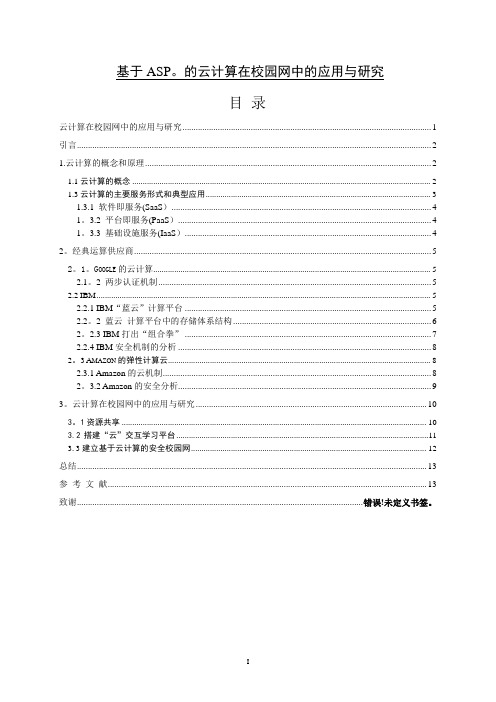
基于ASP。
的云计算在校园网中的应用与研究目录云计算在校园网中的应用与研究 (1)引言 (2)1.云计算的概念和原理 (2)1.1云计算的概念 (2)1.3云计算的主要服务形式和典型应用 (3)1.3.1 软件即服务(SaaS) (4)1。
3.2 平台即服务(PaaS) (4)1。
3.3 基础设施服务(IaaS) (4)2。
经典运算供应商 (5)2。
1。
G OOGLE的云计算 (5)2.1。
2 两步认证机制 (5)2.2IBM (5)2.2.1 IBM“蓝云”计算平台 (5)2.2。
2 蓝云计算平台中的存储体系结构 (6)2。
2.3 IBM打出“组合拳” (7)2.2.4 IBM安全机制的分析 (8)2。
3A MAZON的弹性计算云 (8)2.3.1 Amazon的云机制 (8)2。
3.2 Amazon的安全分析 (9)3。
云计算在校园网中的应用与研究 (10)3。
1资源共享 (10)3.2搭建“云”交互学习平台 (11)3.3建立基于云计算的安全校园网 (12)总结 (13)参考文献 (13)致谢.................................................................................................................................. 错误!未定义书签。
云计算在校园网中的应用与研究摘要本文意从围绕云计算在校园网中的应用展开研究,通过分析现在互联网的几大云计算供应商的安全策略,并结合经典网络安全策略找出一条构建校园网的云计算安全策略,构建校园网安全云环境,达到师生资源共享。
分析了云计算的基本概念、原理、分类和典型应用;研究了经典云计算供应商的云计算平台和安全机制;探讨了云计算在校园网中的典型应用及功能,最后指出建立基于云计算的校园网的困难、问题和发展趋势.关键词云计算;网络安全;云计算供应商; 校园网cloud computing used and explored by the net of campusAbstractThis article is intended from the surrounding cloud computing in the campus network to a study by analyzing the Internet a few big cloud computing vendor's security policy,combined with the classic network security policy to find a cloud computing security policies to build the campus network,build campusnetwork secure cloud environment,to reach students and teachers sharing of resources.Cloud computing the basic concepts, principles,classification and typical applications; classic cloud computing vendor’s cloud computing platforms and security mechanisms;explore cloud computing applications and functions in a typical campus network, and concluded that the establishment of the cloud-based computing the campus network difficulties,problems and development trends.Key wordsCloud Computing; Network Security; Cloud Computing Suppliers;Campus Network引言随着高科技的快速发展,云计算的商业价值被迅速证明,其凭借各种供应商提供更高的服务水平和提供给关键业务应用的平台,已经在企业中获得了巨大的动力。
云计算在大学英语网络建设中应用研究[论文]
![云计算在大学英语网络建设中应用研究[论文]](https://img.taocdn.com/s3/m/761623f84693daef5ef73dcd.png)
云计算在大学英语网络建设中的应用研究云计算作为一种低成本、高效能网络应用模式,正在逐步进入教育领域。
充分利用云计算的优势,构建基于云计算的大学英语网络教学环境,不但可以实现大学英语教学资源共享,提高教学资源的利用率,还能够降低计算机软硬件建设、维护和升级的成本,解决高校教学经费不足问题,进一步推动大学英语教学改革的发展。
云计算大学英语教学教学资源大学英语教学改革中存在着重视硬件初次建设而忽视建设的实用性,重视软件初次投入,却忽略软件资源的二次开发、深入整合等问题,导致资源利用率低,管理难度大,信息和教学资源无法有效共享。
随着在线学习人数的快速增长以及各种教学资源的不断积累,对硬件设备、软件系统的要求越来越高,以往通过升级的方法,也因投入成本的持续升高而难以维持。
在这种情况下,云计算的出现为解决上述大学英语教学所面临的问题提供了良好的技术平台,云计算实现了互联网上资源桌面化,个人计算机性能的最小化。
利用云计算技术,能够实现大学英语教学资源共享,降低教学资源建设、维护和升级的成本,提高现有资源的利用率、避免相同资源的重复建设。
一、现阶段大学英语网络建设存在的问题大学英语教学改革强调利用现代信息技术实施英语教学,高校“没有一定数量的计算机、没有互联网和校园局域网接入就无法开展网络教学活动”(王建梅,孙春雷,2005),这就要求高等院校在计算机软硬件及网络设施上有相当大的投入。
教育部高等学校大学外语教学指导委员会(以下简称大外指导委员会)于2009至2010年对全国高校大学英语教学现状进行了比较全面的调查,在所调研的427所高校中,拥有大学英语教学专用网络机房的有227所,占53.2%(王守仁,王海啸,2011)。
数据表明,普通高等院校在大学英语网络环境建设方面还存在着很大不足,究其原因,主要有以下几个问题:1.建设资金投入大,难以推广大学英语网络教学基础建设的投入主要是电脑、网络、服务器等硬件设备的资金投入,以及供教学和学生自主学习用的多媒体课件,网络资源库等软件平台的建设费用,这些投资动辄几百万,对一些实力雄厚,资金充足的重点大学可能不是什么大的问题,但对于大多数资金来源有限的院校却有着很大的压力。
云计算环境下的协同办公系统的实现-人事管理子系统的设计与实现-英语论文
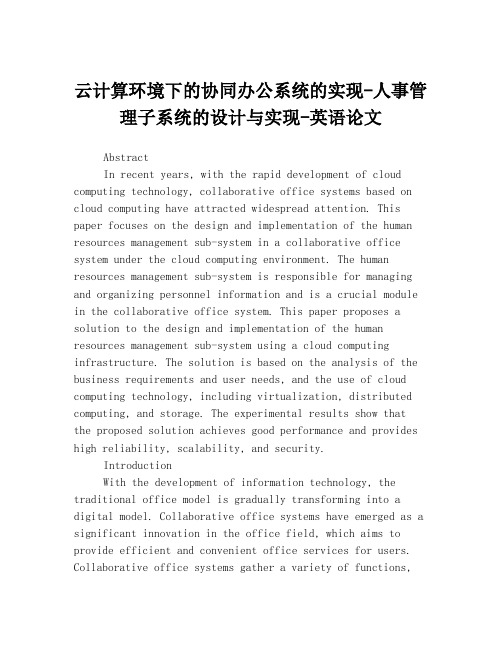
云计算环境下的协同办公系统的实现-人事管理子系统的设计与实现-英语论文AbstractIn recent years, with the rapid development of cloud computing technology, collaborative office systems based on cloud computing have attracted widespread attention. This paper focuses on the design and implementation of the human resources management sub-system in a collaborative office system under the cloud computing environment. The human resources management sub-system is responsible for managing and organizing personnel information and is a crucial module in the collaborative office system. This paper proposes a solution to the design and implementation of the human resources management sub-system using a cloud computing infrastructure. The solution is based on the analysis of the business requirements and user needs, and the use of cloud computing technology, including virtualization, distributed computing, and storage. The experimental results show that the proposed solution achieves good performance and provides high reliability, scalability, and security.IntroductionWith the development of information technology, the traditional office model is gradually transforming into a digital model. Collaborative office systems have emerged as a significant innovation in the office field, which aims to provide efficient and convenient office services for users. Collaborative office systems gather a variety of functions,such as document management, task management, communication, and collaboration, into an integrated platform. Collaborative office systems effectively improve collaboration and work efficiency, reduce costs, and simplify management.As the foundation of collaborative office systems, cloud computing is an important technology for data processing and storage. Cloud computing provides a flexible and scalable infrastructure, and it is widely used in many fields, such as e-commerce, social networking, and scientific research. In a collaborative office system, cloud computing can provide efficient and cost-effective support for collaboration and data management.Human resources management, as a valuable module in the collaborative office system, is responsible for the management and organization of personnel information, employment and separation management, payroll processing, and employee performance management, among others. The importance of human resources management in the collaborative office system cannot be overstated. The development of cloud computing has brought new opportunities for the design and implementation of human resources management sub-systems in collaborative office systems. Cloud computing cansignificantly reduce the complexity of system development, improve system scalability, and enhance the reliability and security of system operation.This paper presents a solution for the design and implementation of the human resources management sub-systemin a collaborative office system based on cloud computing. The system uses virtualization, distributed computing, and storage technologies to achieve high performance and scalability. The proposed solution is based on the in-depthanalysis of business requirements and user needs.Background and Related WorkCollaborative office systems have been researched for many years. Collaborative office systems provide a usefultool for efficient collaboration, communication, and management in the office environment. The development of cloud computing technology has brought new opportunities for collaborative office systems. In the cloud computing environment, collaborative office systems can benefit from scalable and flexible resources, which can significantly reduce the complexity and cost of system development.Human resources management systems are widely used in various industries. Human resources management systems provide useful functions for employee management, such as record management, performance evaluation, and compensation control, among others. The design and implementation of an effective human resources management system is essential for the smooth operation of an organization. Researchers have proposed different solutions for human resources management systems based on cloud computing technology.In [1], the authors proposed a cloud-based human resources management system. The system takes advantage of cloud computing technology to provide efficient and reliable personnel management functions. The system uses a multi-layer architecture and employs different types of virtualization technologies to implement virtual hardware, virtual operating system, and virtual infrastructure. In [2], the authors proposed a cloud-based human resources management system for the construction industry, which aims to manage the human resources of construction projects. The system uses cloud computing, mobile internet, and big data technology toefficiently manage construction personnel. The system adopts a micro-service architecture to achieve high scalability and reliability. In [3], the authors proposed a cloud-based human resources management system for small and medium-sized enterprises. The system uses cloud computing technology to provide a web-based platform for personnel information management. The system implements different virtual environments for different enterprises and provides aflexible and scalable infrastructure.The proposed solution in this paper is mainly based on the use of cloud computing infrastructure, including virtualization, distributed computing, and storage, to provide a robust and efficient human resources management system.Design and Implementation of the Human Resources Management Sub-systemBusiness analysisThe human resources management sub-system mainly implements the functions of personnel information management, employment and separation management, payroll processing, employee performance management, and other related functions. The system needs to meet the following requirements:1. Efficient and accurate personnel information management2. Secure and reliable storage and access of personnel information3. Automated employment and separation management4. Accurate and timely payroll processing5. Automatic calculation and management of employee performance information6. Accessible and user-friendly interfacesTo satisfy the above requirements, the human resources management sub-system is implemented using a cloud computing infrastructure, which provides a scalable and flexible platform for system development and operation.System architectureThe architecture of the human resources management sub-system is shown in Fig 1. The sub-system adopts a multi-layer architecture, including the presentation layer, application layer, and data layer.Fig 1. Architecture of the human resources management sub-systemThe presentation layer is responsible for the display of information and the interaction between users and the system. The presentation layer provides a web-based user interfacefor accessing the system functions. The user interface is designed to be user-friendly and informative, which provides users with a convenient and efficient way of managing personnel information.The application layer implements the system's business logic and the processing of user requests. The application layer is designed as a set of distributed services that can run on different servers and intercommunicate through the message queue. These services help to realize automated employment and separation management, accurate payroll processing, and automatic calculation and management of employee performance information.The data layer provides storage and retrieval of personnel information in a reliable and scalable way. The data layer is designed as a distributed storage system that can store data in multiple copies to ensure data security and high availability. The data layer uses a NoSQL database tostore and manage personnel information.System workflowThe workflow of the human resources management sub-system is shown in Fig 2. The system workflow covers the main functions of the sub-system, which includes personnel information management, employment and separation management, payroll processing, and employee performance management.Fig 2. Workflow of the human resources management sub-system1. Personnel information management. The system collects and stores personnel information, including personal basic information, unit and department information, job information, and education and training information. The personnel information is stored in a distributed NoSQL database, which provides high reliability and scalability.2. Employment and separation management. The system provides automated employment and separation management. The system generates corresponding records when an employee is employed, terminated, or transferred. The system stores employment and separation records in the database and automatically updates personnel information.3. Payroll processing. The system automaticallycalculates and generates employees' salaries based on theirjob and personal information. The system uses a distributed service to calculate salaries and generates related records.4. Employee performance management. The systemcalculates and manages employee performance information, including goal setting, performance appraisal, andperformance feedback. The system generates performancerecords and reports based on the evaluation results.Experimental resultsTo evaluate the proposed solution, we conducted experiments on a cloud computing platform. The experimental environment is set up on the OpenStack platform. The experimental objects include the performance of the system,the scalability of the system, and the security of the system.PerformanceWe conducted stress tests on the human resources management sub-system to assess system performance. Thestress test was carried out with 50, 100, and 200 concurrent user requests. The average response time and throughput ofthe system are shown in Fig 3.Fig 3. Performance test results of the systemAs shown in Fig 3, the average response time of the system was about 0.02s, which means that the human resources management sub-system responds quickly to user requests. The throughput of the system was improved with the increase ofthe concurrent requests, indicating that the system has good scalability.ScalabilityWe tested the scalability of the human resources management sub-system when processing a large amount of data. We tested the system with 10,000, 100,000, and 1,000,000 personnel information records. The system responded correctly and rapidly to the query requests, and there was nosignificant system performance degradation observed.SecurityWe tested the security of the human resources management sub-system by conducting penetration testing. We tested the system for common vulnerabilities, such as SQL injection and XSS attacks. The proposed solution of the human resources management sub-system passed the penetration test andachieved good security.ConclusionThis paper proposed a solution for the design and implementation of the human resources management sub-systemin the collaborative office system based on cloud computing. The human resources management sub-system plays a crucialrole in the collaborative office system, and needs to provide efficient and accurate personnel information management, automated employment and separation management, accurate payroll processing, and automatic calculation and managementof employee performance information. The solution adopts a multi-layer architecture, which uses virtualization,distributed computing, and storage technologies to achievehigh performance and reliability. The experimental results show that the proposed solution achieves good performance and provides high scalability and security. The proposed solution has practical value and can be applied to variouscollaborative office systems.Reference[1] Wang, J., Zhao, Y., Li, W., & Li, J. (2019). Cloud-based human resources management system. Journal of Cloud Computing, 8(1), 1-14.[2] Huang, G., Yu, W., & Zhang, H. (2018). Cloud-based human resources management system for construction projects. International Journal of Sustainable Construction Engineering and Technology, 9(3), 18-29.[3] Zhang, X., Yang, J., & Wu, J. (2017). Cloud-based human resources management system for small and medium-sized enterprises. Journal of Industrial Engineering and Management, 10(4), 721-734.。
英语作文云计算
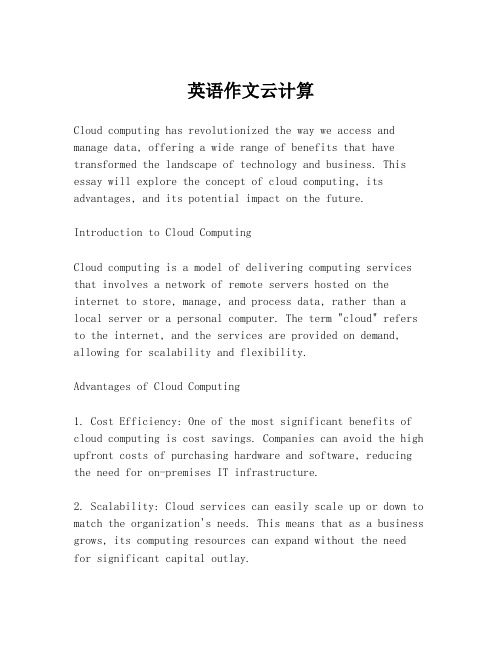
英语作文云计算Cloud computing has revolutionized the way we access and manage data, offering a wide range of benefits that have transformed the landscape of technology and business. This essay will explore the concept of cloud computing, its advantages, and its potential impact on the future.Introduction to Cloud ComputingCloud computing is a model of delivering computing services that involves a network of remote servers hosted on the internet to store, manage, and process data, rather than a local server or a personal computer. The term "cloud" refers to the internet, and the services are provided on demand, allowing for scalability and flexibility.Advantages of Cloud Computing1. Cost Efficiency: One of the most significant benefits of cloud computing is cost savings. Companies can avoid the high upfront costs of purchasing hardware and software, reducing the need for on-premises IT infrastructure.2. Scalability: Cloud services can easily scale up or down to match the organization's needs. This means that as a business grows, its computing resources can expand without the needfor significant capital outlay.3. Accessibility: Data can be accessed from anywhere with an internet connection, which is particularly useful for remote teams and for employees who travel frequently.4. Reliability and Redundancy: Cloud providers typicallyoffer robust security measures and redundancy, ensuring that data is backed up and protected against loss.5. Maintenance and Updates: Cloud providers are responsible for maintaining the servers, which means that users do not have to worry about software updates or hardware maintenance.Impact on the FutureThe future of cloud computing is promising, with continued growth expected in various sectors. As more businesses migrate to the cloud, we can anticipate further advancements in:- Artificial Intelligence (AI): The cloud provides the necessary computational power to train and deploy AI models efficiently.- Internet of Things (IoT): With the proliferation of connected devices, cloud computing will play a crucial rolein managing the vast amounts of data they generate.- Big Data Analytics: Cloud platforms offer the tools and infrastructure needed to process and analyze large datasets, enabling businesses to make data-driven decisions.ConclusionCloud computing has become an integral part of modern technology infrastructure. Its ability to provide cost-effective, scalable, and accessible computing resources has made it an attractive option for businesses of all sizes. As technology continues to evolve, the role of cloud computing is set to expand, shaping the way we work and live in the digital age.This essay provides an overview of cloud computing, highlighting its key benefits and potential future impact. It is designed to give readers a clear understanding of the subject and to encourage further exploration of the topic.。
云计算技术的应用与发展趋势(英文中文双语版优质文档)
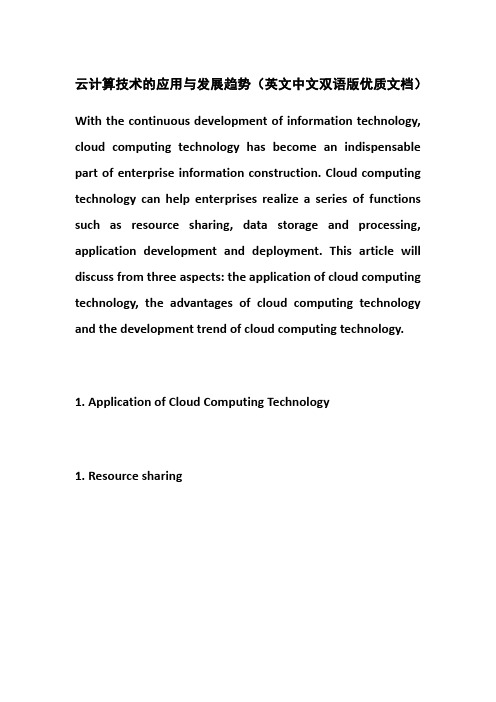
云计算技术的应用与发展趋势(英文中文双语版优质文档)With the continuous development of information technology, cloud computing technology has become an indispensable part of enterprise information construction. Cloud computing technology can help enterprises realize a series of functions such as resource sharing, data storage and processing, application development and deployment. This article will discuss from three aspects: the application of cloud computing technology, the advantages of cloud computing technology and the development trend of cloud computing technology.1. Application of Cloud Computing Technology1. Resource sharingCloud computing technology can bring together different resources to realize resource sharing. Enterprises can use cloud computing technology to share resources such as servers, storage devices, and network devices, so as to maximize the utilization of resources.2. Data storage and processingCloud computing technology can help enterprises store and process massive data. Through cloud computing technology, enterprises can store data in the cloud to realize remote access and backup of data. At the same time, cloud computing technology can also help enterprises analyze and process data and provide more accurate decision support.3. Application development and deploymentCloud computing technology can help enterprises develop and deploy applications faster and more conveniently. Through cloud computing technology, enterprises can deploy applications on the cloud to realize remote access and management of applications. At the same time, cloud computing technology can also provide a variety of development tools and development environment, which is convenient for enterprises to carry out application development.2. Advantages of cloud computing technology1. High flexibilityCloud computing technology can flexibly adjust the usage and allocation of resources according to the needs of enterprises, so as to realize the optimal utilization of resources. At the same time, cloud computing technology can also support elastic expansion and contraction, which is convenient for enterprises to cope with business peaks and valleys.2. High securityCloud computing technology can ensure the security of enterprise data through data encryption, identity authentication, access control and other means. At the same time, cloud computing technology can also provide a multi-level security protection system to prevent security risks such as hacker attacks and data leakage.3. Cost-effectiveCompared with the traditional IT construction model, the cost of cloud computing technology is lower. Through cloud computing technology, enterprises can avoid large-scale hardware investment and maintenance costs, and save enterprise R&D and operating expenses.4. Convenient managementCloud computing technology can help enterprises achieve unified resource management and monitoring. Through cloud computing technology, enterprises can centrally manage resources such as multiple servers, storage devices, and network devices, which is convenient for enterprises to carry out unified monitoring and management.5. Strong scalabilityCloud computing technology can quickly increase or decrease the usage and configuration of resources according to the needs of enterprises, so as to realize the rapid expansion and contraction of business. At the same time, cloud computing technology can also provide a variety of expansion methods, such as horizontal expansion, vertical expansion, etc., to facilitate enterprises to expand their business on demand.3. The development trend of cloud computing technology1. The advent of the multi-cloud eraWith the development of cloud computing technology, the multi-cloud era has arrived. Enterprises can choose different cloud platforms and deploy services on multiple clouds to achieve high availability and elastic expansion of services.2. Combination of artificial intelligence and cloud computingArtificial intelligence is one of the current hot technologies, and cloud computing technology can also provide better support for the development of artificial intelligence. Cloud computing technology can provide high-performance computing resources and storage resources, providing better conditions for the training and deployment of artificial intelligence.3. The Rise of Edge ComputingEdge computing refers to the deployment of computing resources and storage resources at the edge of the network to provide faster and more convenient computing and storage services. With the development of the Internet of Things and the popularization of 5G networks, edge computing will become an important expansion direction of cloud computing technology.4. Guarantee of security and privacyWith the widespread application of cloud computing technology, data security and privacy protection have become important issues facing cloud computing technology. In the future, cloud computing technology will pay more attention to security measures such as data encryption, identity authentication and access control to ensure the security and privacy of corporate and personal data.To sum up, cloud computing technology has become an indispensable part of enterprise information construction. Through cloud computing technology, enterprises can realize a series of functions such as resource sharing, data storage and processing, application development and deployment. At the same time, cloud computing technology also has the advantages of high flexibility, high security, high cost-effectiveness, convenient management and strong scalability. In the future, with the multi-cloud era, the combination of artificial intelligence and cloud computing, the rise of edge computing, and the protection of security and privacy, cloud computing technology will continue to enhance its importance and application value in enterprise information construction.随着信息技术的不断发展,云计算技术已经成为企业信息化建设中不可或缺的一部分。
云计算-专业英语论文
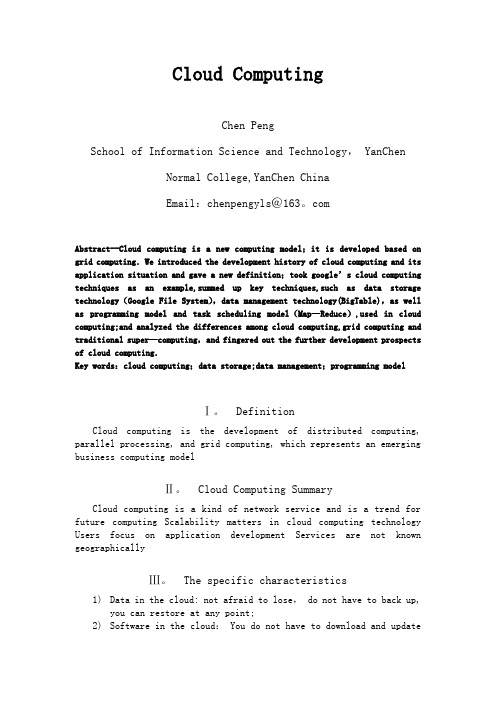
Cloud ComputingChen PengSchool of Information Science and Technology, YanChenNormal College,YanChen ChinaEmail:chenpengyls@163。
comAbstract--Cloud computing is a new computing model;it is developed based on grid computing.We introduced the development history of cloud computing and its application situation and gave a new definition;took google’s cloud computing techniques as an example,summed up key techniques,such as data storage technology(Google File System),data management technology(BigTable),as well as programming model and task scheduling model(Map—Reduce),used in cloud computing;and analyzed the differences among cloud computing,grid computing and traditional super—computing,and fingered out the further development prospects of cloud computing.Key words:cloud computing;data storage;data management;programming modelⅠ。
云计算论文
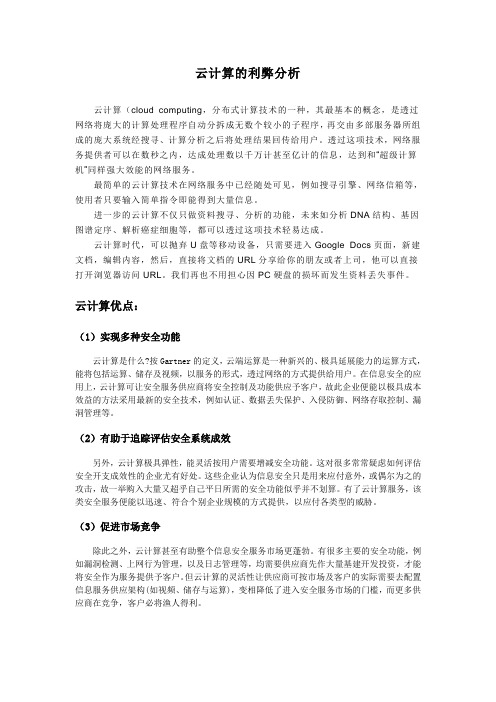
云计算的利弊分析云计算(cloud computing,分布式计算技术的一种,其最基本的概念,是透过网络将庞大的计算处理程序自动分拆成无数个较小的子程序,再交由多部服务器所组成的庞大系统经搜寻、计算分析之后将处理结果回传给用户。
透过这项技术,网络服务提供者可以在数秒之内,达成处理数以千万计甚至亿计的信息,达到和“超级计算机”同样强大效能的网络服务。
最简单的云计算技术在网络服务中已经随处可见,例如搜寻引擎、网络信箱等,使用者只要输入简单指令即能得到大量信息。
进一步的云计算不仅只做资料搜寻、分析的功能,未来如分析DNA结构、基因图谱定序、解析癌症细胞等,都可以透过这项技术轻易达成。
云计算时代,可以抛弃U盘等移动设备,只需要进入Google Docs页面,新建文档,编辑内容,然后,直接将文档的URL分享给你的朋友或者上司,他可以直接打开浏览器访问URL。
我们再也不用担心因PC硬盘的损坏而发生资料丢失事件。
云计算优点:(1)实现多种安全功能云计算是什么?按Gartner的定义,云端运算是一种新兴的、极具延展能力的运算方式,能将包括运算、储存及视频,以服务的形式,透过网络的方式提供给用户。
在信息安全的应用上,云计算可让安全服务供应商将安全控制及功能供应予客户,故此企业便能以极具成本效益的方法采用最新的安全技术,例如认证、数据丢失保护、入侵防御、网络存取控制、漏洞管理等。
(2)有助于追踪评估安全系统成效另外,云计算极具弹性,能灵活按用户需要增减安全功能。
这对很多常常疑虑如何评估安全开支成效性的企业尤有好处。
这些企业认为信息安全只是用来应付意外,或偶尔为之的攻击,故一举购入大量又超乎自己平日所需的安全功能似乎并不划算。
有了云计算服务,该类安全服务便能以迅速、符合个别企业规模的方式提供,以应付各类型的威胁。
(3)促进市场竞争除此之外,云计算甚至有助整个信息安全服务市场更蓬勃。
有很多主要的安全功能,例如漏洞检测、上网行为管理,以及日志管理等,均需要供应商先作大量基建开发投资,才能将安全作为服务提供予客户。
关于云计算的英语作文
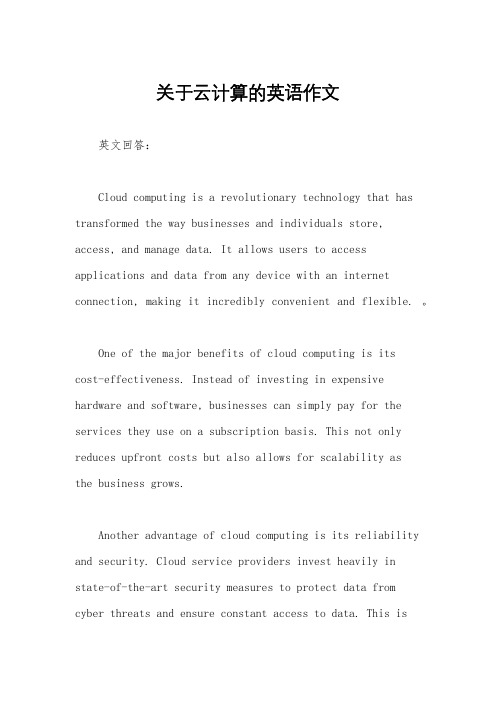
关于云计算的英语作文英文回答:Cloud computing is a revolutionary technology that has transformed the way businesses and individuals store, access, and manage data. It allows users to access applications and data from any device with an internet connection, making it incredibly convenient and flexible. 。
One of the major benefits of cloud computing is itscost-effectiveness. Instead of investing in expensive hardware and software, businesses can simply pay for the services they use on a subscription basis. This not only reduces upfront costs but also allows for scalability asthe business grows.Another advantage of cloud computing is its reliability and security. Cloud service providers invest heavily instate-of-the-art security measures to protect data from cyber threats and ensure constant access to data. This isparticularly important for businesses that rely on data for their operations.Furthermore, cloud computing enables collaboration and remote work. With cloud-based applications and storage, teams can work together on projects from different locations, making it easier to stay connected and productive.In addition, cloud computing has had a significant impact on the entertainment industry. Streaming services like Netflix and Spotify rely on cloud computing to deliver content to millions of users simultaneously, without any lag or interruption.Overall, cloud computing has revolutionized the way we store and access data, and its impact can be seen across various industries.中文回答:云计算是一项革命性的技术,改变了企业和个人存储、访问和管理数据的方式。
计算机英语论文(5篇)
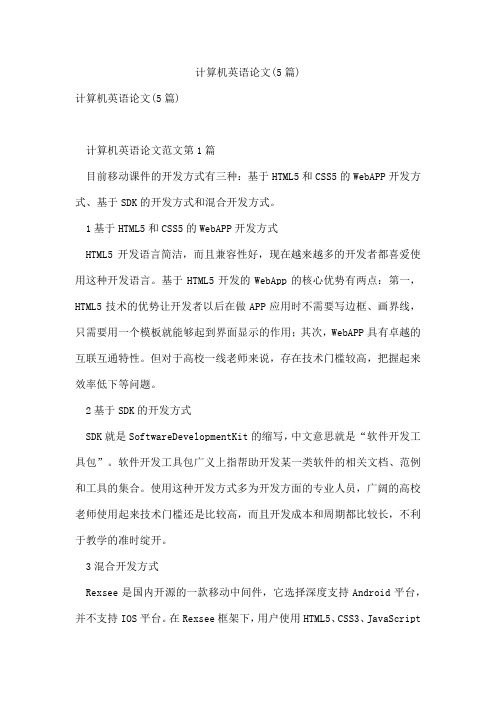
计算机英语论文(5篇)计算机英语论文(5篇)计算机英语论文范文第1篇目前移动课件的开发方式有三种:基于HTML5和CSS5的WebAPP开发方式、基于SDK的开发方式和混合开发方式。
1基于HTML5和CSS5的WebAPP开发方式HTML5开发语言简洁,而且兼容性好,现在越来越多的开发者都喜爱使用这种开发语言。
基于HTML5开发的WebApp的核心优势有两点:第一,HTML5技术的优势让开发者以后在做APP应用时不需要写边框、画界线,只需要用一个模板就能够起到界面显示的作用;其次,WebAPP具有卓越的互联互通特性。
但对于高校一线老师来说,存在技术门槛较高,把握起来效率低下等问题。
2基于SDK的开发方式SDK就是SoftwareDevelopmentKit的缩写,中文意思就是“软件开发工具包”。
软件开发工具包广义上指帮助开发某一类软件的相关文档、范例和工具的集合。
使用这种开发方式多为开发方面的专业人员,广阔的高校老师使用起来技术门槛还是比较高,而且开发成本和周期都比较长,不利于教学的准时绽开。
3混合开发方式Rexsee是国内开源的一款移动中间件,它选择深度支持Android平台,并不支持IOS平台。
在Rexsee框架下,用户使用HTML5、CSS3、JavaScript就可以进行移动开发,无需了解Android和Java,服务器端支持使用任何语言,支持在线编译生成APK客户端,无需使用Eclipse等工具,特别适合教学第一线老师开发APP课件使用。
二、课件的开发过程依据以上各方面对比介绍,本文选择使用基于Rexsee框架下的混合开发方式,课件的开发过程如下:下载javaJDK。
到网页中选择“JDK”下载。
在AcceptLicenseAgreement前选择后依据计算机型号选择JDK下载文件,我的是win7操作系统,64位,所以选择jdk-8u25-windows-x64.exeWin7操作系统下安装JDK。
- 1、下载文档前请自行甄别文档内容的完整性,平台不提供额外的编辑、内容补充、找答案等附加服务。
- 2、"仅部分预览"的文档,不可在线预览部分如存在完整性等问题,可反馈申请退款(可完整预览的文档不适用该条件!)。
- 3、如文档侵犯您的权益,请联系客服反馈,我们会尽快为您处理(人工客服工作时间:9:00-18:30)。
Cloud ComputingChen PengSchool of Information Science and Technology, YanChenNormal College,YanChen ChinaEmail:Abstract--Cloud computing is a new computing model;it is developed based on grid computing.We introduced the development history of cloud computing and its application situation and gave a new definition;took google’s cloud computing techniques as an example,summed up key techniques,such as data storage technology(Google ),data management technology(BigTable),as well as programming model and task scheduling model(Map—Reduce),used in cloud computing;and analyzed the differences among cloud computing,grid computing and traditional super-computing,and fingered out the further development prospects of cloud computing.Key words:cloud computing;data storage;data management;programming modelⅠ. DefinitionCloud computing is the development of distributed computing, parallel processing, and grid computing, which represents an emerging business computing modelⅡ. Cloud Computing SummaryCloud computing is a kind of network service and is a trend for future computing Scalability matters in cloud computing technology Users focus on application development Services are not known geographicallyⅢ. The specific characteristics1)Data in the cloud: not afraid to lose, do not have to back up,you can restore at any point;2)Software in the cloud: You do not have to download and updateyourself ;3)Ubiquitous computing: at any time, any place, any device, login to enjoy computing services;4)Powerful computing: unlimited space, unlimited speedⅣ. The main forms of service1)Software as a Service(SaaS)2)SaaS service providers deploy application software on theserver, users on demand ordered from the manufacturer via the Internet, service providers charge based on customer's needs, and to provide customers with the software through a browser.3)Platform as a Service(PaaS)4)Manufacturers provide a development environment, serverplatforms, hardware resources services to customers, custom develop their own application and pass through its servers and the Internet to other customers5)Infrastructure services(IaaS)6)"Cloud" infrastructure consisting of multiple servers, providemeasurement services to customers.Ⅴ. Characteristics1)In general, cloud computing customers do not own the physicalinfrastructure, instead avoiding capital expenditure by renting usage from a third-party provider. They consume resources as a service and pay only for resources that they use. Many cloud-computing offerings employ the utility computing model, which is analogous to how traditional utility services (such as electricity) are consumed, whereas others bill on a subscription basis. Sharing "perishable and intangible" computing power among multiple tenants can improve utilization rates, as servers are not unnecessarily left idle (which can reduce costs significantly while increasing the speed of application development). A side-effect of this approach is that overall computer usage rises dramatically, as customers do not have to engineer for peak load limits. In addition, "increased high-speed bandwidth" makes it possible to receive the same response times from centralized infrastructure at other sites.2)The cloud is becoming increasingly associated with small andmedium enterprises (SMEs) as in many cases they cannot justify or afford the large capital expenditure of traditional IT. SMEs also typically have less existing infrastructure, less bureaucracy, more flexibility, and smaller capital budgets forpurchasing in-house technology. Similarly, SMEs in emerging markets are typically unburdened by established legacyinfrastructures, thus reducing the complexity of deployingcloud solutionsⅥ. Origins of cloud computingIn 2006,Google engineer Christophe suggest Google CEO Eric Schmidt the idea of "cloud computing“ at the first time, under the support of Schmidt, Google rollout "Google 101 plan "and formally proposed the concept of “cloud ".Google's concept of “cloud computing” is a picturesque phrase, to describe Google's business model and computing technology architecture in a romantic way.therefore, cloud computing consists two levels of meaning, in commercial level, just the "cloud“; in the technical level is "computing",combined the cloud and computing to illustrate that Google is different with traditional software and hardware companies in business models and computing architecture. This is just a very beautiful and very romantic metaphor.Ⅶ. Brief IntroductionApache Hadoop is a framework for running applications on large cluster built of commodity hardware. The Hadoop framework transparently provides applications both reliability and data motion. Hadoop implements a computational paradigm named Map/Reduce, where the application is divided into many small fragments of work, each of which may be executed or re-executed on any node in the cluster. In addition, it provides a distributed (HDFS) that stores data on the compute nodes, providing very high aggregate bandwidth across the cluster. Both MapReduce and the Hadoop Distributed are designed so that node failures are automatically handled by the framework.Ⅷ. Two Important Technical1)HDFS: Hadoop Distributed (HDFS) is designed to reliably storevery large files across machines in a large cluster. It is inspired by the Google.2)MapReduce: MapReduce is a programming model for processing largedata sets with a parallel, distributed algorithm on a cluster.Ⅸ. The future of cloud computing1)Cloud computing is seen as the next revolution of the technologyindustry, it will bring a fundamental change in working methods and business models.2)Once cloud computing has been widely promoted,we can predictthe upcoming spring of the super computer market !REFERENCES[1]VARIA J.Clouda rchitectures—Amazon Web serviees[EB/OLl.[2009一03—0l]..org/events/monthly-talk/may-2008-cloud—architectures—amazon-web-service.html[2] BRYANT R E.Data—intensive supercomputing:The case for DISC.CMU—CS-07—128[R].Pittsburgh,PA,USA:Carnegie Mellon University.Department of Computer Science.2007.[3] SZALAY A S,KUNSZT P,THAKAR A,et al.Designing and mining multi—terabyte astronomy archives:The sloan digital sky survey[CJ]Proceedings of the 2000 ACM SIGMOD International Conference on Managementof Data.New YoA:ACM Press,2000:451—462.[4]BARROSOL A,DEAN J,HOLZLEU.Web search for a planet:The Gongle cluster architecture[J].IEEE Micro.2003,23(2):22—28.[5] GILES J.Google tops translation ranking[EB/OL].(2006—11一06)[2009—03一06 1.http://.corn/news/2006/061 106/full/news061 106-6.html.[6]维基白.科.Cloud computingl EB/OL].[2009—03—10]..wikipedia.org/wiki/Cioud—.computing.[7]中国云计算网.什么是云计算?[EB/OLl.(2008—05一14) [2009—02—27].http://.cn/Artiele/ShowArtiele.asp.9AttielelD=1.[8] VAQUERO L M,RODERO-MERINO L.CACERES J,et al.Abreakin the clouds:Towardsa cloud definition[J].ACM SIG-COMM Computer CommunicationReview.2009.39(I):50—55.[9]WEISS A.Computing in the clouds[J].ACM Networker,2007,11(4):16—25.。
